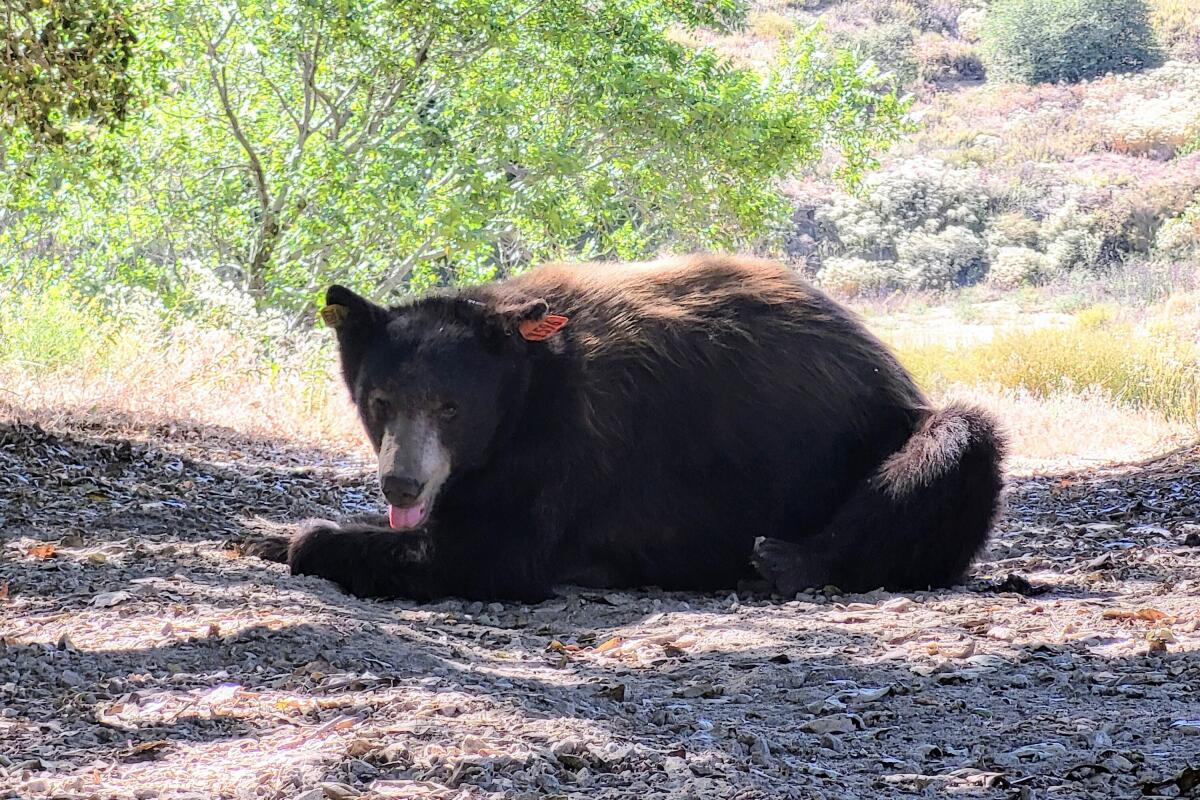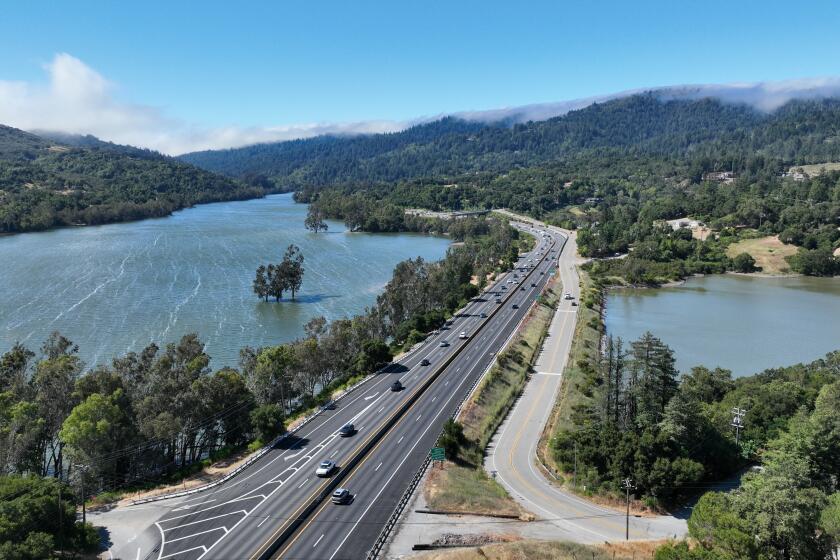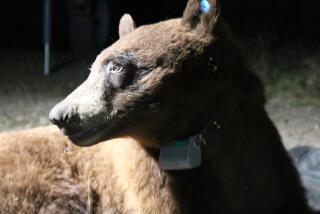Chatsworth bear may pave the way for new wildlife crossings

- Share via
A bear taking the scenic route around Southern California may help researchers learn how wild animals cross freeways to get from one habitat to the next — and how they might be kept out of your backyard.
Known to the California Department of Fish and Wildlife as Yellow 2291, the adult female black bear wandered into a trap near Claremont on May 31. There, researchers gave her a GPS-tracking collar and transported her north into the Angeles National Forest mountains.
Last week, the bear was removed from a Chatsworth tree and taken back to the forest, only to be spotted over the weekend in a Sylmar neighborhood.
“This female bear’s just saying, ‘Yeah, I’m just gonna take a little trip across Southern California,’” said Jessica West, a regional wildlife conflict specialist at the state Department of Fish and Wildlife who monitors Yellow 2291 and other tagged bears.
Since her initial trapping, Yellow 2291 took a long trek from the 210 Freeway corridor into the Malibu area. From the 210 corridor, she probably used an underpass or other unknown crossing at the Newhall Pass interchange of the 5 Freeway and Highway 14. She cut across the 118 Freeway into the Santa Monica Mountains and spent time near Pacific Coast Highway in the Malibu area. Then she walked back toward the Angeles National Forest, according to state wildlife officials.
Amid recent reports of two mountain lions dying on the highway, many communities are turning to wildlife crossings and fencing to reduce roadkill.
She climbed into a tree inside a business complex in Chatsworth, where she was tranquilized and moved back to the national forest last week. She wandered back down the mountain and was recognized in residential Sylmar over the weekend, before heading back into the forest foothills Monday morning.
West said it’s uncharacteristic of female bears to wander so much. Male black bears have larger home ranges than females, she said, and tend toward this type of erratic movement. But for those researchers studying connectivity, or how animals move from one habitat to another across developed areas of Southern California, this bear’s movement may be key.
“If we can figure out where about she was crossing, either under or over these freeways, that can really influence” where future wildlife crossings should go, West said.
The Wallis Annenberg Wildlife Crossing, which is being built over the 10-lane 101 Freeway near Agoura Hills, is one of several crossings under construction or in development in the state. Tracking Yellow 2291’s movement is step one in connecting habitats fragmented by freeways and neighborhoods while keeping them out of residential areas, according to Beth Pratt, regional executive director of the National Wildlife Federation.
“That is the good data and research needed for any crossing,” said Pratt, leader of the #SaveLACougars campaign, which was a key advocate for the 101 Freeway crossing. “The animals are our guide,” she said.
“Their whole existence is spent, every day, trying to get enough calories — and picture you’re doing that in the middle of the most densely populated metropolitan area in the country,” Pratt said. Rebuilding connectivity between suitable habitats means bears and other wild scavengers will be less likely to wander up to your trash cans looking for a quick snack, and more likely to stay in the wildlands.
A California black bear visited a residential property on Canyon Crest Drive on Saturday and left with a package of the Nabisco treat.
Yellow 2291’s recent relocations may be a factor in her relentless wandering, according to Pratt. “If you were relocated, you’re gonna try to come back to the same place as well.” If she is not from the Angeles National Forest, where Fish and Wildlife officials believe she is from, she may be trying to find her original stomping ground.
“They don’t have options when there are 10-lane freeways in their way,” Pratt said. “If there’s a fire and you need to move, and a road’s in your way, it cuts off your escape mechanism,” she said.
Two years ago, a study found mountain lions were crossing busy roadways to escape the 2018 Woolsey fire, resulting in a higher chance of them being hit by a vehicle or dying in territorial disputes with other mountain lions. This summer, an unprecedented heat wave has brought triple-digit temperatures and threatened to cause more and bigger wildfires.
Over the last month, two mountain lions were found dead, one near the unfinished 101 Freeway crossing and another on the 405 Freeway. In May, a Placer County black bear was killed after being hit by a car, before having its paws cut off.
For Yellow 2291, crossing the 5 Freeway to summer in Malibu might be a conscious choice. “Animals are individuals,” Pratt said, “And, indeed, if she’s picked this as her home — which, rightly so, I mean, bears were on the landscape before we were — it’s not that she necessarily shouldn’t be there. It’s just that she should be able to come and go without it being a death sentence. And her luck is probably going to run out at some point.”
More to Read
Sign up for Essential California
The most important California stories and recommendations in your inbox every morning.
You may occasionally receive promotional content from the Los Angeles Times.













